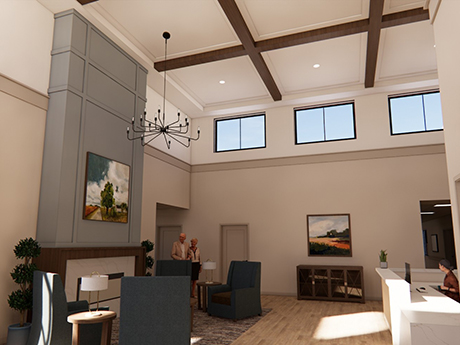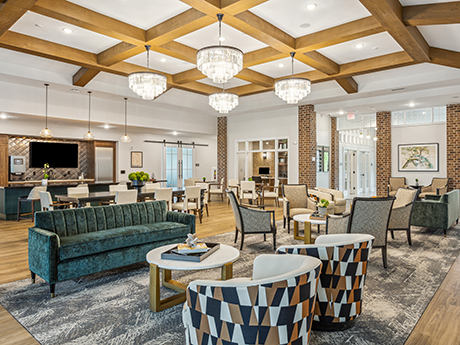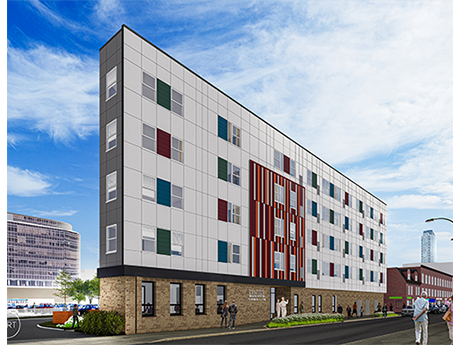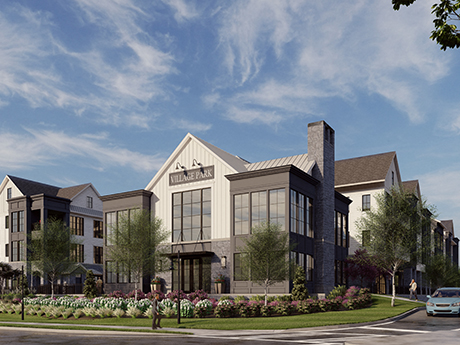Demographic shifts prompt developers to focus on fast-growing cities in the South and West to attract new residents.
Which markets are hot? While developers scour the Mountain West and Mid-Atlantic states for promising sites, one senior living investor likes the somewhat unlikely spot of Rockford, Illinois.
LTC Properties (NYSE: LTC), a real estate investment trust, has provided a construction loan for The Courtyard at Loves Park, a 116-unit senior living project under development in Loves Park, Illinois, a suburb of Rockford. The mid-size, Midwestern city with a rocky history after the industrial slump of the 1980s is now showing signs of life.

Located 90 miles northwest of Chicago, Rockford was named the hottest housing market in an April survey by The Wall Street Journal and Realtor.com. Rockford scored the top spot for its affordability and growing economy driven by the healthcare, aerospace and logistics industries. Home prices in the Rockford market have surged 72 percent in the last five years.
That kind of growth should translate into success for The Courtyard at Loves Park, according to Michael Bowden, vice president of investments at Westlake Village, California-based LTC. The development is expected to open in the second quarter of 2026. Chicago-based Encore Senior Living will operate the campus.
Another mid-size market that LTC has invested in is Lansing, Michigan, the capital city of the Great Lakes State. The REIT is the senior lender on a new senior living project which will also be operated by Encore.
“We’re not shying away from the Midwest,” says Bowden, whose office is in Atlanta, Georgia. He explains that LTC relies on long-standing relationships such as those with Avenue Development and Encore Senior Living. LTC’s partners find attractive opportunities in markets they know and understand.
“We’re not going into overbuilt or stagnant markets,” says Bowden. “No one is rushing to put shovels in the ground in those markets.”
As capital and construction costs have risen, ground-up development has slowed dramatically (see sidebar page 18), but interest in promising markets has not. Developers, owners, operators and investors continue to seek out the best spots.
Hot markets have strong demographics. Developers look for areas with high population growth and a large concentration of seniors.
Aging baby boomers are expected to boost demand. The number of seniors 80 years old and above is projected to grow significantly over the next 25 years, according to NIC MAP Vision based in Raleigh, North Carolina. Its 2024 outlook report says, “To keep pace, the industry will need historic near-term inventory growth.”
But where?
Texas and Florida are the top two states for population growth, according to the U.S. Census Bureau. Texas, Florida and California have large, and growing, older populations.
“The demographics have to be there,” says Joe Jedlowski, CEO at Distinctive Living, a developer, owner and operator based in Freehold, New Jersey. The company also has an office in Tampa. “We look at age and income-qualified metrics, market growth and many other factors,” he adds.
Look South and West
Senior living developers like growth markets in sought-after retirement destinations with large existing senior populations. The Sun Belt states are good examples. “The market follows the market,” says Chuck Murphy, senior managing director of development at LCS. Headquartered in Des Moines, Iowa, LCS oversees about 145 senior living communities.
The top three metro areas with the most seniors housing units under construction as of the third quarter of 2024 were Raleigh, North Carolina; San Jose, California; and Washington, D.C., according to NIC MAP Vision’s list of top 10 markets (see table page 18).
As of 2023, Raleigh was America’s third fastest-growing big city, behind only Atlanta and Fort Worth, according to the U.S. Census Bureau. At the end of the third quarter of 2024, Raleigh had 1,351 senior living units underway, or 16.3 percent of the existing inventory.
Hayes Barton Place, for example, a new life plan community in Raleigh, is expected to open early this year. It will feature 214 independent living units as well as 85 assisted living, memory care and skilled nursing units. The project is owned and operated by Liberty Senior Living of Raleigh. Liberty has communities throughout the Southeast.
Markets that fly under the radar are getting more attention too. Boise, Idaho, for example, ranks 8th on NIC MAP Vision’s top 10 list with 293 units under construction.
Between 2014 and 2024, the Boise metro area consistently ranked among the fastest-growing regions in the nation, according to the U.S. Census. Utah-based Stellar Senior Living announced a new 145-unit project in Boise last August.
Competition, of course, is a big consideration. It’s no secret which markets are growing quickly. And finding the right submarket in a growing market is a big challenge. A stampede of new development only leads to overbuilding, soft occupancies and low returns.
“The Southeast is attractive,” notes Murphy at LCS. “But there’s a lot of competition.”
Some markets, particularly in Florida and Texas, are overbuilt, sources say.
Active Adult Everywhere
Product matters. The active adult segment continues to grow quickly in many markets. The product is still relatively new, but it faces less competition than traditional senior housing.
“Every market provides opportunity,” says Adam Cohan, senior director and Active Adult leader for Greystar Real Estate Partner’s Principal Investment Business, headquartered in Charleston, South Carolina.
“Relative to other product types, the supply-demand fundamentals are extremely compelling, with very little existing active adult product compared to the age-qualified renter demand that continues to grow. We continue to be bullish and are focused on the top 25 markets,” adds Cohan.
Greystar owns and operates about 75 active adult properties and manages about another 40 communities. Many are located in the Sunbelt, but the company continues to explore growth in the coastal markets.
The company’s goal is to develop seven to 10 projects a year starting in the latter half of 2025 through 2027.

Active adult rents continue to see strong growth despite slower near-term growth in conventional multifamily rents. And active adult rents are significantly below independent living rents — which makes the active adult sector compelling, says Cohan. Also, construction costs are starting to flatten and, he adds, “Feasibility is getting easier.”
Greystar has new active adult projects underway in Phoenix and Philadelphia. Seven other projects are in the development pipeline in the Mid-Atlantic region, Sunbelt, Pacific Northwest and Mountain West.
“The Midwest is more challenging today,” says Cohan. He explains that there is ample demand for the active adult product in the Midwest, but the achievable development yields today are not attractive to investors. They want a higher return in the Midwest because of general migration trends away from the region.
“It’s just hard to find scale in the Midwest,” says Cohan, “but there are some interesting acquisition opportunities.”
Distinctive Living is mostly active along the East Coast. The company is developing projects in Maryland and New Jersey and looking at several markets in Texas.
“There are hot markets in every state,” says Jedlowski at Distinctive Living. “We’re looking at development sites throughout the United States.”
The company has about 50 assets in its portfolio, a combination of owned and operated and managed properties.
“It makes sense to develop. But you have to be in the right market,” he says, emphasizing the need for strong demographics.
Jedlowski looks for high barrier-to-entry markets. These places are difficult to build in due to a strict regulatory environment and other factors.
On the plus side, other developers shy away from thorny markets so there’s less competition. Coupled with increasing demand, high barrier-to-entry markets provide a great opportunity, he adds.
To meet demand for a lower cost product, Distinctive Living is introducing Live Well Senior Cottages. The concept consists of pocket neighborhoods set on about 20 acres of land. The communities have a total of about 120 freestanding units or cottages.
The projects have shared outdoor spaces, walking paths and a clubhouse. A big difference is that home care services will be available on site. Rents are about half of traditional assisted living rents. The first Live Well projects are located near Philadelphia in Vineland and Winslow, New Jersey.
“No one has developed this kind of housing model,” says Jedlowski.
Choose Sites Wisely
Affordable seniors housing is in demand everywhere. In 2021, nearly 11.2 million older adults were cost burdened, meaning they spent more than 30 percent of their household income on housing costs, an all-time high, according to a report by Harvard University’s Joint Center for Housing Studies. The number of cost burdened households is expected to grow as the older population increases.
While the demand for affordable housing is widespread, not every market is hot. Developers focus on markets they know where tax credits and other government subsidies are available to finance new projects.
“We can fill affordable senior living buildings quickly,” says David Block, director of development at Chicago-based Evergreen Real Estate Group. “But getting them built is challenging.”
Block’s office is in Vermont. “We are looking for development opportunities in New England,” he says. Likely spots include Vermont, New Hampshire, Connecticut, Maine and Upstate New York. “You have to choose sites intelligently,” he says.
Evergreen owns about half of the15,000 units it manages. The company opened Bellwood Senior Living in late 2023. It is located in Bellwood, a western suburb of Chicago. It features 80 affordable apartments for independent seniors.
Evergreen is building a similar project in Leyden Township, just north of Bellwood. It is slated to open in mid-2026 and will feature 80 affordable apartments. Evergreen is also building a senior center on an adjacent site in partnership with the township.
The total project cost is about $46 million financed with tax credits and other government funding and a small mortgage.
“Not a lot of local governments can provide the $10 million to $15 million in funding beyond the tax credits to make it happen,” says Block.
Pennrose Properties, based in Philadelphia, is a large owner and developer of affordable housing. It has 20 senior affordable housing projects in its pipeline.
The projects are at varying stages of development across the country in Massachusetts, Tennessee, Pennsylvania, Virginia, Maryland, Arizona, New Jersey, Colorado, Ohio and Texas.
Markets are selected based on feasibility.

“It’s not enough to say there’s a booming population of needy seniors in a market,” says Charlie Adams, president of development at Pennrose. “There has to be a matchup between rents and what seniors can afford to pay.”
Rents are set at a level that would be affordable to individuals earning a certain percentage of the area median income which varies by location. But Adams says the area median income in many places is going up faster than a senior’s income and ability to pay the rent.
“It’s becoming more difficult for seniors to afford affordable housing,” he says.
Rising labor and construction costs are also impacting the ability to keep rents low in desirable markets. “Construction costs are sticky,” says Block at Evergreen.
He estimates that labor and construction prices are 30 to 50 percent higher than they were before the pandemic.
“Prices are going to stay there,” predicts Block. “It has a big impact on the whole industry.”
— Jane Adler
This article was originally published in the December 2024-January 2025 issue of Seniors Housing Business magazine.

